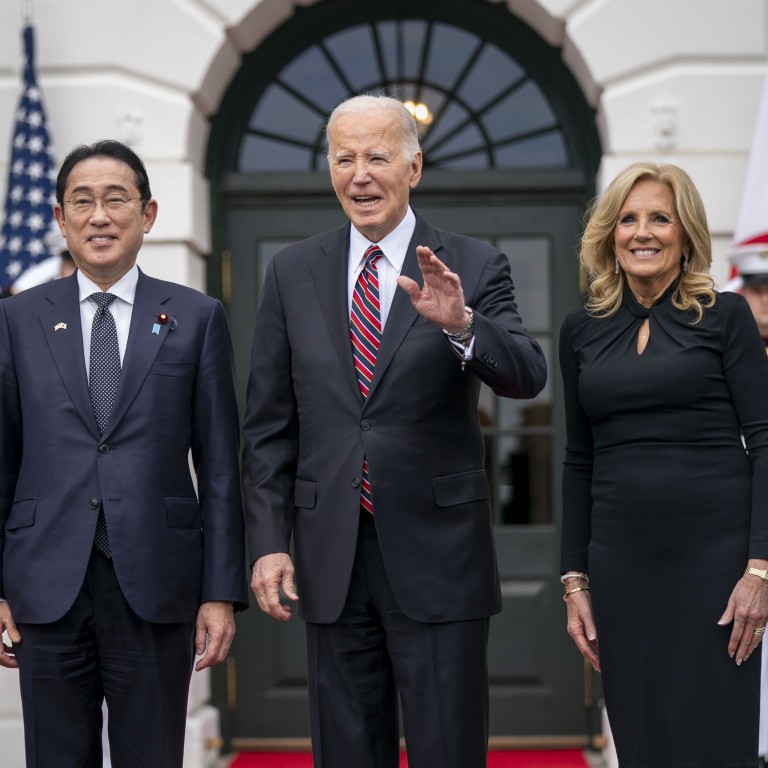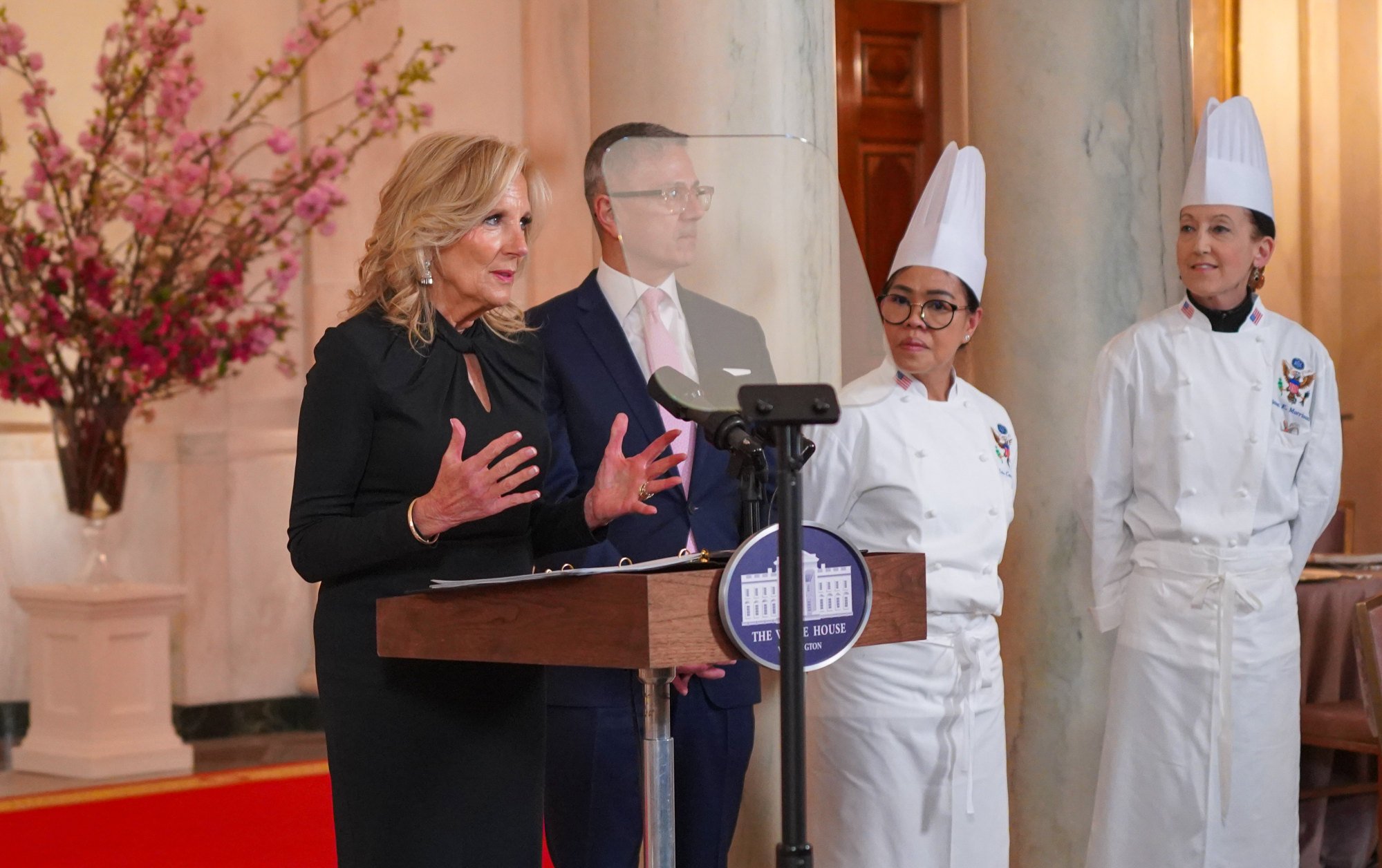
As US and Japan keep an eye on China, Biden-Kishida meeting to yield outcomes on ‘remarkable’ scale: insiders
- Leaders will unveil nearly six dozen ‘deliverables’ in security, economic and people-to-people areas, senior US officials say before summit
- US officials acknowledge foreign anxiety over whether new partnerships under Indo-Pacific strategy will last if Trump becomes president
US President Joe Biden and Japanese Prime Minister Fumio Kishida will unveil nearly six dozen “deliverables” in security, economic and people-to-people areas on Wednesday, senior Biden administration officials said hours before the leaders met.
“We will judge it to be a remarkable summit,” one of the officials said of the projected number of outcomes. “Seventy is not common. Occasionally we have a dozen, maybe 20 at the outside. This is probably the largest number of substantial deliverables that we’ve seen of its kind.”
The officials declined to provide specifics but indicated that many would relate to reorganising and integrating their two militaries and new joint operating command structures. Some 54,000 US troops are stationed in Japan.
US officials warned that even after particulars were disclosed, the reorganisation would take months as the two defence bureaucracies wrangle over details and implementation.
Other announcements on Wednesday are expected to involve tapping Japan’s formidable manufacturing expertise to fill gaps in the overstretched US military-industrial structure with construction of US naval vessels, aircraft and other equipment years behind schedule.
Also expected are several people-to-people announcements: an artificial intelligence partnership between Carnegie Mellon and Keio universities, several Japanese firms and Microsoft; a US$50 million tie-up between Washington state’s University of Washington, the University of Tsukuba, Amazon and Nvidia; and the creation of a US$12 million fund to promote high school exchanges between the two countries.

Beyond the deliverables, officials said, this week’s summits underscored the merits of prioritising a latticework of groupings. When China tries to punish Australia or the Philippines economically or militarily and allies respond with joint naval patrols and trilateral arrangements, it is ultimately Beijing that stands alone, they said.
“The country that’s isolated is China, not the Philippines,” another senior official said, with the leading partner being Japan. “In the past, it was all about the defence of Japan. They are stepping beyond that … They are a global partner.”
US officials acknowledged there was anxiety in foreign capitals over whether newly minted partnerships under Washington’s Indo-Pacific strategy would last should Biden lose his re-election bid to former president Donald Trump in November. Some countries had decided to lie low, others doubled down, they said. But they expressed confidence the architecture would withstand the test of time.
“We think it creates a momentum of its own,” one official said.
Although US-Japan relations are increasingly close, officials declined to say definitively whether Japan was ready to join the Five Eyes – an intelligence alliance composed of Australia, Canada, New Zealand, Britain and the US – or fight alongside the US in a war.
“It’s fair to say our Japanese partners have taken substantial steps on information security,” one official said. “There is still more work to do.”
Biden and Kishida will also join a trilateral summit on Thursday with Philippine President Ferdinand Marcos Jnr as the Biden administration works to bolster its network of Indo-Pacific economic and security agreements amid growing tension in the waters around the Philippines.
In addition to meetings with Biden and a state dinner on Wednesday night in the East Room, Kishida has been invited to address a joint meeting of Congress on Thursday to be only the second Japanese leader to address the body after prime minister Shinzo Abe spoke in 2015.

At a media preview of the 230-guest dinner, Jill Biden said the menu would reflect the long-term partnership between the two allies, including rib-eye steak, shishito pepper butter and shiso leaf fritters.
One blemish colouring ties between the two leaders is Biden’s decision last month to oppose a US$41 billion takeover bid by Nippon Steel for US Steel on national security grounds.
“The president has made it clear that he will always stand up for American workers,” said Mira Rapp-Hooper, special assistant to the president for East Asia and Oceania. “But he’s equally strong and he has conviction that he will always stand up for the US-Japan alliance. I’ll leave it at that.”
The US ambassador to Japan, Rahm Emanuel, in Washington for the prime minister’s visit, sought on Monday to downplay the effect of the Nippon rejection on the relationship – noting that the Biden administration approved a multibillion US dollar deal in February for Japan’s Mitsui Engineering & Shipbuilding to build container cranes.
“The United States’ relationship with Japan is a lot deeper and stronger and more significant than a single commercial deal,” Emanuel said.
Japanese lawmaker says US Steel deal would help counter China dominance
Biden has focused heavily on the Pacific since coming to power as a way to counter China’s rising economic and military might, even as the administration has been forced to grapple with Russia’s invasion of Ukraine and the war between Israel and Hamas.
As it has become more stretched, it has increasingly leaned on Japan to pursue economic and diplomatic initiatives with Southeast Asia and Pacific Island nations.
China has expanded its island building activity in the South China Sea, increasingly challenged US “freedom of navigation” flights and voyages, used water cannons and other tactics against Philippine vessels and greatly expanded its coastguard and naval fleet in recent years.
Beijing maintains that much of the contested South China Sea is solely its territory.

Biden administration officials repeatedly say these are not aimed at any particular country, and so far Beijing has not reacted particularly strongly, although analysts said they were taken aback by the Seoul-Tokyo link given China’s long history of divide-and-conquer tactics involving its two neighbours.
“We oppose cobbling together exclusive groupings and stoking bloc confrontation in the region,” Chinese foreign ministry spokeswoman Mao Ning said on Monday.
“The US-Philippine mutual defence treaty applies to the Philippines in the South China Sea,” Rapp-Hooper said. “We stand strongly by our alliance commitments to the Philippines and that is one of the things we will be talking to President Marcos about.”
US ‘back in force’ in Pacific as Biden engages with regional leaders at summit
Marcos will be looking for some economic and diplomatic benefits he can take home to voters to show his tough stance against China is paying dividends, according to analysts.
“Even if this is a US-China conflict, there will be Philippine sailors involved,” said Jeremy Chan, a geopolitical analyst with the Eurasia Group. “They’re the marines on the Sierra Madre ship, ground zero. There’s absolutely a Philippine domestic component.”
Additional reporting by Khushboo Razdan


